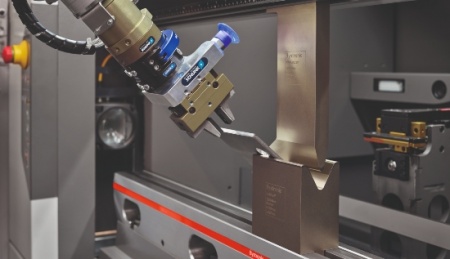
Bystronic’s Bendikt Kreisel describes the benefits of a fully automatic bending cell in today’s sheet metal processing.
Not long ago, automation was associated only with repetitive tasks. High and consistent quality as well as reliability over very long periods are decisive factors that ensure the profitability of automation in production environments. However, more complex jobs that require a high degree of customisation in the manufacturing process are still often performed manually. This is currently a widespread approach in the sheet metal processing sector.
Our industry has experienced a major transformation over the past five years–indeed, one could say it has been forced to transform. Increasing price pressure in the markets and the lack of skilled personnel are just two of the reasons for this, in addition to increasingly dynamic and uncertain business environments.
Automation Backlog
However, the unique advantages and disadvantages of manual processing by a human operator and automated manufacturing cannot be dismissed. Every decision in favor of or against automating a process is a balancing act involving many production-relevant variables. Besides productivity and quality, flexibility is another undeniable competitive advantage of any supplier in the manufacturing industry, especially in view of increasingly dynamic business environments.
This is a dilemma that has led to a backlog of automation, especially in the sheet metal processing industry. However, when users do not wish to accept any compromises in terms of flexibility, productivity, and consistent high quality, the demands on the machines increase.
Intelligent Technology Solution
Bystronic’s Mobile Bending Cell addresses these demands and implements them by applying intelligent technology. The users’ requirements are particularly wide-ranging when it comes to bending technology. Being able to bend parts with extremely complex geometries in small batches while simultaneously being capable of handling the high-volume processing of simple geometries is a major challenge that many companies are currently facing. Also known as automation on demand, the Mobile Bending Cell is capable of overcoming these challenges—ensuring high flexibility as well as high quality and productivity.
This is achieved by means of the Mobile Bending Robot, which can be positioned in front of the press brake or detached to allow manual operation. Thanks to an intelligent and fully automated measuring system, the robot references itself in front of the press brake without requiring manual intervention. Laser sensors measure the precise position of the robot relative to the press brake and it is referenced accordingly. This allows the press brake to be converted from manual bending to fully automated bending in less than ten minutes. The relative position of the press brake to the Mobile Bending Robot is determined so accurately that the need for manual calibration is completely eliminated.
Once individual parts have been bent automatically, the process can be repeated without adjustments once the press brake and the Mobile Bending Robot have been connected. Depending on the requirements, the system can either be operated completely manually or fully automatically.
However, the “marriage” of press brake and Mobile Bending Robot is not the only critical factor for an efficient production process. The preparation of the parts that are to be bent is another process that incurs costs in every production run. For the automation on demand concept to really pay off, the process of programming the robot automation needs to be innovative and fast.
With the Mobile Bending Cell’s programming system called Robot Manager, the robot’s movements are programmed using algorithms that factor in comprehensive collision models for each relevant application. All that is required is the definition of basic positions and all the other movements are automatically defined by the software. This increases quality and reduces process idle time.
Automatic measurement of the press brake and bending automation system in combination with intelligent robot programming makes the Mobile Bending Cell the ideal solution for bending automation on demand.
